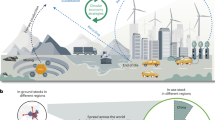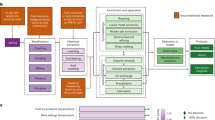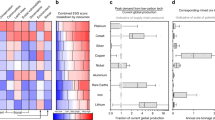Abstract
Rare earths are essential to a wide array of different technologies, including clean technology. However, rare earths production has a large environmental footprint, warranting a greening of the industry. We quantify environmental impacts from rare earths production in China and project pathways towards sustainability of the industry to 2025 under different scenarios for development. We show that net environmental cost–benefits in 2015 were −US$14.8 billion (net cost). This cost would increase to −US$16 billion by 2025 under a reference scenario and fall to −US$6 billion by 2025 in the most environmentally friendly scenario. The single strategy that can reduce environmental impacts the most is to tackle illegal mining. Doing so would include increased regulatory enforcement and can yield significant eco-cost savings (US$5 billion). However, it may also tighten supply of rare earths and ignite market volatility, particularly in an uncertain global trade climate. A complementary strategy of relaxing restrictions on legal production can contribute to higher eco-cost savings while concurrently meeting global demand for rare earths.
This is a preview of subscription content, access via your institution
Access options
Access Nature and 54 other Nature Portfolio journals
Get Nature+, our best-value online-access subscription
$29.99 / 30 days
cancel any time
Subscribe to this journal
Receive 12 digital issues and online access to articles
$119.00 per year
only $9.92 per issue
Buy this article
- Purchase on Springer Link
- Instant access to full article PDF
Prices may be subject to local taxes which are calculated during checkout




Similar content being viewed by others
Data availability
All data used to perform this study can be found in the Supplementary Datasheets. A discussion on methodology and assumptions are also available in the Supplementary Information. Any additional data that were used to support this study are available upon request from the authors.
References
Tyrer, M. & Sykes, J. in The Statistics of the Rare Earths Industry Vol. 10 12–16 (Royal Statistical Society, 2013).
Nassar, N., Du, X. & Graedel, T. Criticality of the rare earth elements. J. Ind. Ecol. 19, 1044–1054 (2015).
Zaimes, G., Hubler, B., Wang, S. & Khanna, V. Environmental life cycle perspective on rare earth oxide production. ACS Sustain. Chemi. Eng. 3, 23–244 (2014).
Lee, J. & Wen, Z. Rare earths from mines to metals: comparing environmental impacts from China’s main production pathways. J. Ind. Ecol. 21, 1277–1290 (2017).
Sprecher, B. et al. Life cycle inventory of the production of rare earths and the subsequent production of NdFeB rare earth permanent magnets. Environ. Sci. Technol. 48, 3951–3958 (2014).
Vahidi, E., Navarroc, J. & Zhao, F. An initial life cycle assessment of rare earth oxides production from ion-adsorption clays. Resour. Conserv. Recycl. 113, 1–11 (2016).
Goonan, T. G. Rare Earth Elements—End Use and Recyclability (United States Geological Service, Reston, 2011).
Alonso, E. et al. Evaluating rare earth element availability: a case with revolutionary demand from clean technologies. Envir. Sci. Tech. 46, 3406–3414 (2012).
Nugent, D. & Sovacool, B. Assessing the lifecycle greenhouse gas emissions from solar PV and wind energy: a critical meta-survey. Energy Policy 65, 229–244 (2014).
IPCC Climate Change 2014: Mitigation of Climate Change Annex III (eds Edenhofer, O. et al.) (Cambridge Univ. Press, 2014).
Weng, Z., Haque, N., Mudd, G. M. & Jowitt, S. M. Assessing the energy requirements and global warming potential of the production of rare earth elements. J. Clean. Prod. 139, 1282–1297 (2016).
Pavel, C. et al. Substitution strategies for reducing the use of rare earths in wind turbines. Resour. Policy 52, 349–357 (2017).
USGS Rare Earth Statistics and Information (United States Geological Survey, 2017); http://minerals.usgs.gov/minerals/pubs/commodity/rare_earths/
Yang, H., Huang, X., Thompson, J. & Flower, R. Enforcement key to China’s environment. Science (Insights) 347, 834–835 (2015).
Wübbeke, J. Rare earth elements in China: policies and narratives of reinventing an industry. Resour. Policy 38, 384–394 (2013).
Ma, Y. et al. Study on the decomposition of Baotou rare earth concentrate (in Chinese). Chinese Rare Earths 31, 20–23 (2010).
Yang, X. J. et al. China’s ion-adsorption rare earth resources, mining consequences and preservation. Environ. Devel. 8, 131–136 (2013).
Miller, J. & Zheng, A. Molycorp files for bankruptcy protection. The Wall Street Journal (25 June 2015); http://www.wsj.com/articles/SB10907564710791284872504581069270334872848
Paul, S. Lynas rare earths revenue jumps as output grows. Reuters (15 October 2014); http://www.reuters.com/article/2014/10/14/lynas-corp-rareearths-idUSL3N0S916R20141014
Zaimes, G., Hubler, B., Wang, S. & Khanna, V. Environmental life cycle perspective on rare earth oxide production. ACS Sustain. Chem. Eng. 3, 237–244 (2015).
Schulze, R., Lartigue-Peyrou, F., Ding, J., Schebek, L. & Buchert, M. Developing a life cycle inventory for rare earth oxides from ion-adsorption deposits: key impacts and further research needs. J. Sustain. Metall. 3, 753–771 (2017).
Zapp, P., Marx, J., Schreiber, A., Friedrich, B. & Voßenkaul, D. Comparison of dysprosium production from different resources by life cycle assessment. Resour. Conserv. Recycl. 130, 248–259 (2018).
Ehsan Vahidi, F. Z. Environmental life cycle assessment on the separation of rare earth oxides through solvent extraction. J. Environ. Manage. 203, 255–263 (2017).
The Model of the Eco-costs / Value Ratio (EVR) (TU Delft, 2017); http://www.ecocostsvalue.com/index.html
2009–2015 Rare Earths Industry Development Plan (in Chinese) (Chinese Ministry of Industry and Information Technology, 2009).
Situation and Policies of China’s Rare Earth Industry (White Paper) (Chinese Information Office of the State Council, 2012).
Chinese National Development and Reform Commission Department of Industry. Special Report: Rare Earth—2013 (in Chinese). Rare Earth Inf. 3, 4–7 (2014).
Ge, J., Lei, Y. & Zhao, L. Chinaas rare earths supply forecast in 2025: a dynamic computable general equilibrium analysis. Minerals 6, 95 (2016).
Daniel Packey, D. K. The impact of unregulated ionic clay rare earth mining in China. Resour. Policy 48, 112–116 (2016).
Seaman, J. Rare Earths and Clean Energy: Analyzing China’s Upper Hand (French Institute for International Relations, Paris, 2010).
Rare Earth Industry Dilemma: Difficult to Get Rid of Black Rare Earths Still Hitting the Market (in Chinese) (IC Consulting, 2016); http://www.ocn.com.cn/chanye/201606/hlvpn23120746.shtml
Wang, S. Experts Say That the Illegal Exploitation of Rare Earths in China Amounts to About 40,000 Tons Per Year (in Chinese) (Wangyi Finance, 2013); http://money.163.com/14/1031/11/A9SPLRHG002524SO.html#from=keyscan
Chinese National Development and Reform Commission Department of Industry. Special Report: Rare Earth—2011 (in Chinese). Rare Earth Inf. 3, 4–7 (2012).
Nguyen, R. & Imholte, D. China’s rare earth supply chain: illegal production, and response to new cerium demand. JOM 68, 1948–1956 (2016).
(2016–2020) Rare Earths Industry Development Plan (in Chinese) (Chinese Ministry of Industry Information and Technology, 2016).
Wang, L. et al. Towards cleaner production of rare earth elements from bastnaesite in China. J. Clean. Prod. 165, 231–242 (2017).
Xiao, Y. et al. Study on non-saponification extraction process for rare earth separation. J. Rare Earth 31, 512–516 (2013).
Notice for the Rare Earths Cleaner Production Technology Promotion Plan (in Chinese) (Chinese Ministry of Industry Information and Technology, 2014).
Steen, B. A. Abiotic resource depletion: different perceptions of the problem with mineral deposits. Int. J. Life Cycle Ass. 1, 49–54 (2006).
Rao, Z. Consolidating policies on Chinese rare earth resources. Miner. Econ. 29, 23–28 (2016).
Cai, Q. US’s only rare earth producer went bankrupt; is China subsidizing the west? (in Chinese) China Economics (2016); http://finance.ce.cn/rolling/201601/15/t20160115_8289945.shtml
Notice of Chinese Ministry of Land Resources 2014 Rare Earth and Tungsten Ore Total Mining Quotas (in Chinese) (Chinese Ministry of Land Resources, 2014).
Notice of Chinese Ministry of Land Resources 2015 Rare Earth and Tungsten Ore Total Mining Quotas (in Chinese) (Chinese Ministry of Land Resources, 2015).
Notice of Chinese Ministry of Land Resources 2016 Rare Earth and Tungsten Ore Total Mining Quotas (in Chinese) (Chinese Ministry of Land Resources, 2016).
Wang, G. Current mining situation and potential development of rare earth in China (in Chinese). Sichuan Rare Earth 3, 4–8 (2009).
Chen, Z. Outline on the Development and Policies of China Rare Earth Industry (Chinese Society of Rare Earths, Beijing, 2010).
IKE eBalance v. 4.7.14122.508 (IT Knowledge & Education, Sichuan University, Chengdu, 2015).
Chinese Life Cycle Database (IT Knowledge & Education, Sichuan University, Shenzhen, 2012); http://www.ike-global.com/products-2/chinese-lca-database-clcd
Ecoinvent Data (Ecoinvent Centre, 2017); http://www.ecoinvent.org
European Reference Life Cycle Database v.3.0 (Joint Research Centre European Platform on Life Cycle Assessment, European Commission, 2014); http://eplca.jrc.ec.europa.eu/ELCD3/
Acknowledgements
The authors are grateful for financial support from the National Natural Science Foundation for Outstanding Young Scholars of China (grant no. 71522011), National Basic Research Programme of China (grant no. 2010CB955903) and Commonwealth Programme on Environmental Protection (grant no. 200809062) of Ministry of Environmental Protection of China. Additional thanks go to J. Vogtländer and the rest of his team at TU Delft for their work on eco-cost and making it publicly available for other researchers and our team at Tsinghua University.
Author information
Authors and Affiliations
Contributions
J.L. and W.Z. co-designed the study, contributed to data collection and drafted the paper. J.L. carried out technical analyses and compiled the supplementary information with input and feedback from W.Z.
Corresponding author
Ethics declarations
Competing interests
The authors declare no competing interests.
Additional information
Publisher’s note: Springer Nature remains neutral with regard to jurisdictional claims in published maps and institutional affiliations.
Supplementary information
Supplementary Information
Supplementary Methods, Supplementary Figure 1, Supplementary Tables 1–10, Supplementary References 1–38
Supplementary Dataset
1 spreadsheet with 6 Supplementary datasheets
Rights and permissions
About this article
Cite this article
Lee, J.C.K., Wen, Z. Pathways for greening the supply of rare earth elements in China. Nat Sustain 1, 598–605 (2018). https://doi.org/10.1038/s41893-018-0154-5
Received:
Accepted:
Published:
Issue Date:
DOI: https://doi.org/10.1038/s41893-018-0154-5
This article is cited by
-
Accumulation of rare earth elements in common vine leaves is achieved through extraction from soil and transport in the xylem sap
Communications Earth & Environment (2023)
-
Comprehensive assessment of food waste treatment emission reduction in China: a life cycle perspective
Environmental Science and Pollution Research (2023)
-
Diversity and distribution of bryophytes in ion-type rare earth mines in southern Jiangxi Province, southeast China, and the implications for vegetation restoration
Plant and Soil (2023)
-
Selective sulfidation of metal compounds
Nature (2022)
-
A green and efficient technology to recover rare earth elements from weathering crusts
Nature Sustainability (2022)



